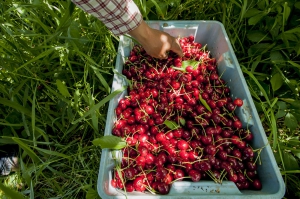Through July 6th, Northwest cherry growers have shipped 15.2 million 20-lb. boxes of fruit. That’s 21 percent more than the previous record and 124 percent more than the 15-year industry average.
Here’s the report issued yesterday by B.J. Thurlby, president of Northwest Cherry Growers:
Through yesterday, July 6th, the Northwest cherry industry has shipped 15.2 million 20-pound boxes of fruit. That’s 21% more than the industry’s previous shipment high, and 124% more than the 15-year industry average. However the fact remains that there was simply not enough fruit available to meet all of the demand for the 4th of July promotions. Americans love cherries, and it showed. Per our industry, we expect to see another 4 to 5 million boxes over the rest of the season.
Retailers in general maintained great displays of sweet cherries, and as we move past the 4th of July, should be primed to capture those Late Season sales. With the early start to the season and extended heat, the Northwest cherry season will see one of the earliest conclusions in recent history in just a few short weeks. Purchase records show that 17% of cherry buyers each year don’t make their first purchase until the Northwest late season. Their trigger? A countdown notice – letting them know that the time to squeeze the last bit of summer out of Northwest cherries is upon them.
A cherry harvest near Prosser, Washington. (TJ Mullinax/Good Fruit Grower)
Our growers are predominantly picking the later-ripening varieties, and reports from the shelves and orchards are uniform in the comments of high-quality. We are averaging 380,000 boxes a day as an industry, and expect to see volume continuing but generally trending downward throughout the month of July. Nielsen Research studies showed on other large-volume crops similar to 2015, the difference in dollar sales between a top and bottom performing retailer during the last 5 weeks of the season equaled an average of $1.2 million dollars for a 100-store chain. The two most important differences between the top and the bottom? The number of cherry items for sale (think reds AND Rainiers) and the visibility of the category within the retailer’s promotional strategy.
Soon the air will cool and bring Fall and Back-to-School promotions, but for the remaining few weeks of the month, retailers have an opportunity to boost their sales with the Number One Dollar per Square Foot Item in their produce departments.







Leave A Comment